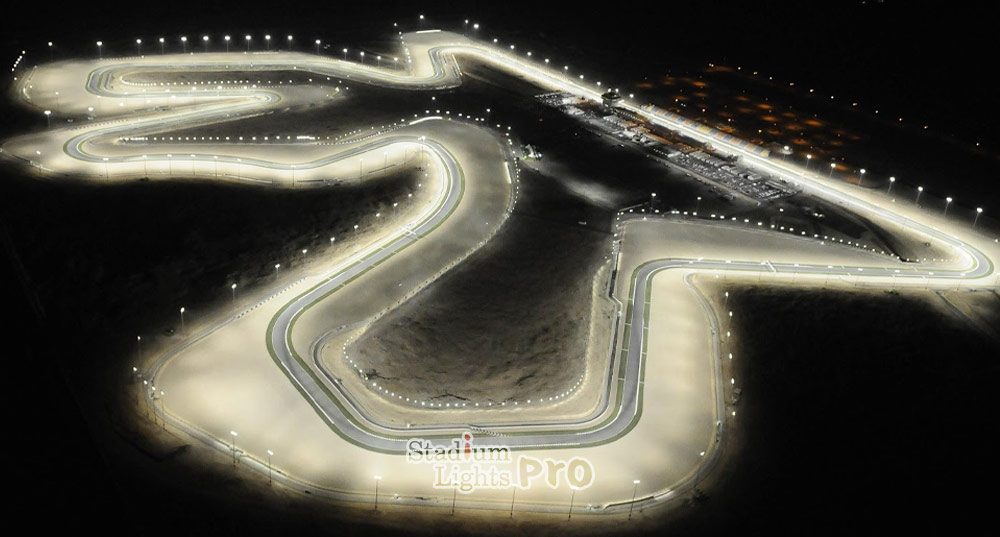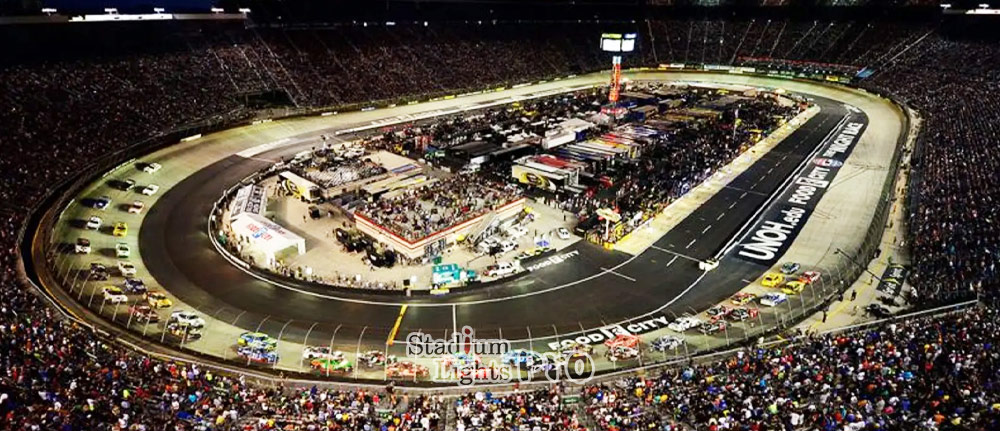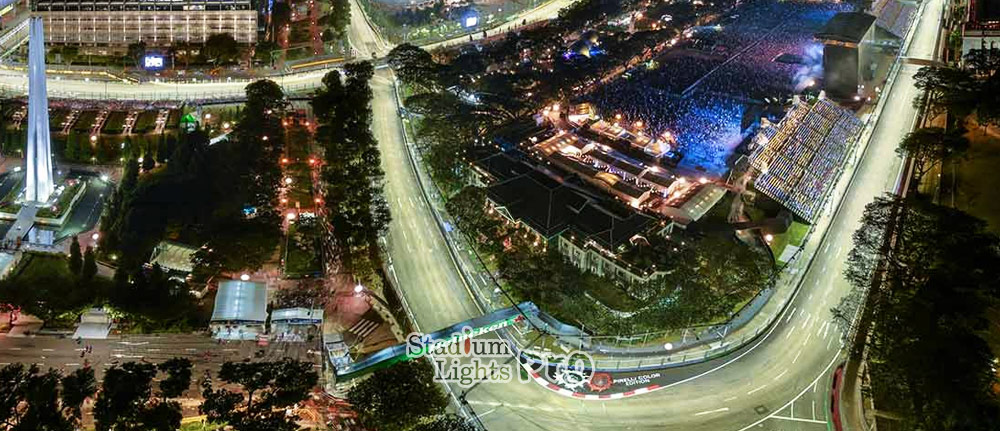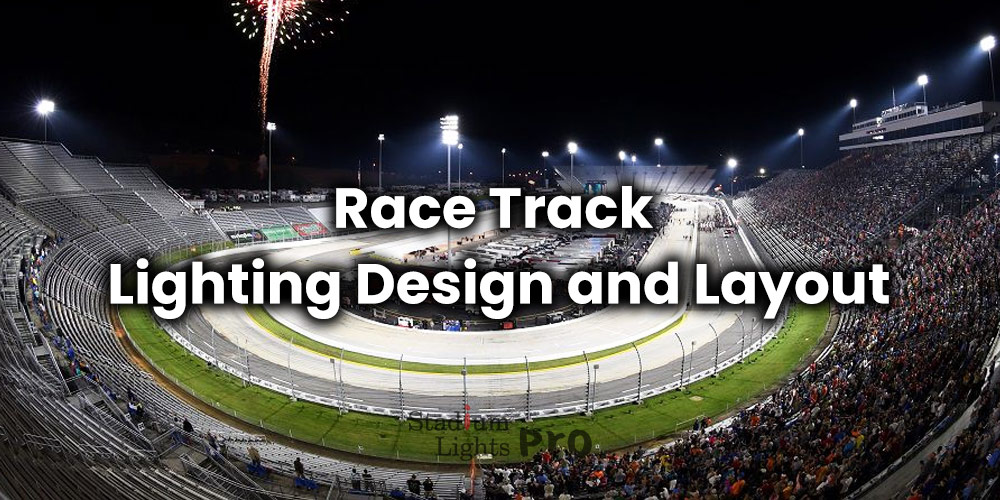Race track lighting design and layout refers to the planning and installation of lighting systems on racetracks to provide adequate illumination for drivers and spectators. Proper lighting is crucial for the safe operation of race tracks and the visibility of drivers and other track personnel. It is also a key factor in creating an exciting and immersive experience for spectators.
The layout of race track lighting involves the placement and distribution of lights to ensure optimal visibility and safety on the track. This includes calculating the number of lights needed for a particular track and ensuring that they are spaced and positioned appropriately. Proper maintenance of race track lighting is also essential to ensure that the lighting system is operating at its best and to extend its lifespan.
Table of Contents
ToggleThe importance of proper lighting on race tracks

Proper lighting on race tracks is essential for the safety of drivers and other track personnel, as well as for the visibility of drivers and spectators. Adequate lighting is necessary for drivers to see the track and any obstacles or hazards that may be present. It is also necessary for track marshals and other personnel to see and respond to any incidents that may occur on the track.
In addition to safety considerations, proper lighting is also critical for the overall experience of spectators at a race. Proper lighting can create an immersive and exciting atmosphere for spectators, enhancing their enjoyment of the event.
Without proper lighting, race tracks can be dangerous for drivers and track personnel, and the experience of spectators may be negatively impacted. It is therefore necessary to consider and plan the lighting design and layout on race tracks to ensure the safety and enjoyment of all involved.
Factors to consider when designing race track lighting
Types of race tracks
Oval tracks

These tracks are shaped like a rectangle with rounded corners and are primarily used for stock car racing and open-wheel racing. Oval tracks typically have a relatively high banking (the slope of the track) in the corners to allow for high speeds.
We need to provide sufficient visibility for drivers around the entire track, including the corners and straightaways. The lighting should be bright enough to allow drivers to see any obstacles or hazards on the track, while also being energy efficient and cost-effective.
Road courses

These tracks are designed to mimic a public road and include a variety of turns, both left and right. Road courses can be used for various types of racing, including touring car racing, sports car racing, and motorcycle racing.
Lighting should be designed to provide visibility around the entire track, including through turns and over hills. It may be necessary to have different lighting levels or types of lighting in different areas of the track to ensure optimal visibility.
Drag strips
These tracks are designed for drag racing and typically feature a straight, flat surface with a starting line and a finish line.
Drag strips typically require lighting that is focused on the starting line and finish line, as well as any areas where spectators may be present. The lighting should be bright enough to allow drivers to see the track and any obstacles or hazards, as well as to provide an exciting atmosphere for spectators.
Kart tracks

These tracks are smaller and are designed for go-kart racing. They can be either indoor or outdoor tracks and may include a variety of turns and straightaways.
Kart tracks may have similar lighting requirements to road courses, depending on the layout and characteristics of the track. We need to ensure that the lighting is bright enough for drivers to see the track and any obstacles, while also being energy efficient and cost-effective.
Hillclimbs
These tracks are designed for racing up an incline, often on a dirt or gravel surface. Hillclimbs can be either individual events or part of a larger racing series.
Hillclimbs need lighting that is focused on the starting line and finish line, as well as any areas where spectators may be present. The lighting should be bright enough to allow drivers to see the track and any obstacles or hazards, as well as to provide an exciting atmosphere for spectators. It may also be necessary to consider the lighting needs of any support personnel or medical personnel who may be present at the event.
Location and weather conditions
The lighting system should be designed to meet the specific needs of the track and its location.
For example, if the track is located in an area with extreme weather conditions, such as high winds or heavy rain, the lighting system should be designed to withstand these conditions. This may involve using lighting fixtures that are designed to be wind-resistant or waterproof.
The time of day and the amount of natural light present at the track may also impact the lighting design. If the track is located in an area with long hours of daylight, the lighting system may not need to be as bright or may not need to be used as frequently. Conversely, if the track is located in an area with shorter hours of daylight, the lighting system may need to be brighter and used more frequently.
The location of the track may also impact the type of lighting system that is used. For example, a track located in an area with a high solar energy potential may be well-suited to a solar-powered lighting system, while a track located in an area with less sunshine may be better served by a different type of lighting system.
Visibility and safety for drivers and spectators
Ensuring visibility and safety for drivers and spectators is a key factor in race track lighting design and layout. Adequate lighting is necessary for drivers to see the track and any obstacles or hazards that may be present. It is also necessary for track marshals and other personnel to see and respond to any incidents that may occur on the track.
To ensure visibility and safety, the lighting system should be designed to provide sufficient illumination around the entire track, including through turns and over hills. It may be necessary to have different lighting levels or types of lighting in different areas of the track to ensure optimal visibility.
In addition to providing visibility for drivers and track personnel, we may consider the visibility of spectators. Proper lighting can enhance the experience of spectators and create an immersive and exciting atmosphere at the track.
Energy efficiency and cost-effectiveness
The lighting system should be designed to provide sufficient illumination while also being energy efficient and cost-effective.
There are a number of ways to improve the energy efficiency and cost-effectiveness of race track lighting. One approach is to use LED lights, which are known for their energy efficiency and long lifespan. LED lights use less energy and generate less heat compared to other types of lighting, which can help to reduce energy costs and extend the lifespan of the lighting system.
Another approach is to use solar-powered lighting systems, which can be a cost-effective option for tracks located in areas with high solar energy potential. Solar-powered systems can help to reduce energy costs and reduce the track’s carbon footprint.
A lighting system that requires frequent maintenance or replacements may be more expensive to operate in the long run compared to a system with a longer lifespan and lower maintenance needs.
Types of lighting systems used on race tracks
High-intensity discharge (HID) lamps
HID lamps use an electric arc to produce light and are known for their high luminous efficiency, which means that they are able to produce a lot of light using relatively little energy.
HID lamps come in two main types: metal halide lamps and high-pressure sodium lamps. Metal halide lamps produce a white or bluish-white light, while high-pressure sodium lamps produce a yellowish light. Both types of HID lamps are commonly used on race tracks and are known for their bright and efficient lighting.
One advantage of HID lamps is that they have a relatively long lifespan compared to other types of lighting, which can make them a cost-effective choice. However, they do require a warm-up period before they reach their full brightness and may not be suitable for applications where lighting needs to be turned on and off frequently. HID lamps also generate more heat than other types of lighting, which may be a consideration in some applications.
LED lights
LED (light-emitting diode) lights are a type of lighting that is commonly used on race tracks. LED lights are known for their energy efficiency, long lifespan, and ability to produce bright and even lighting.
LED lights use significantly less energy compared to other types of lighting, such as incandescent or HID lamps. This can help to reduce energy costs and lower the carbon footprint of a race track. LED lights also have a long lifespan and are relatively low maintenance, which can make them a cost-effective choice in the long run.
They are available in a wide range of colors and can be used to create various lighting effects on a race track. They are also capable of being turned on and off quickly, making them suitable for use in applications where lighting needs to be adjusted frequently.
Solar-powered lighting systems
Solar-powered lighting systems are a type of lighting that is powered by solar panels, which convert sunlight into electricity. Solar-powered lighting systems are a sustainable and cost-effective option for lighting race tracks, particularly for tracks located in areas with high solar energy potential.
The system consists of solar panels, a battery to store the electricity generated by the panels, and lighting fixtures. The solar panels are typically installed on a pole or other structure and are oriented to face the sun. The panels generate electricity, which is stored in the battery and used to power the lighting fixtures.
Solar-powered lighting systems have a number of merits for use on race tracks. They are sustainable and do not rely on fossil fuels, which can help to reduce the carbon footprint of the track. They are also relatively easy to install and maintain, and do not require a connection to the electrical grid.
Yet, solar-powered lighting systems may not be suitable for all race tracks. They may not be as bright as other types of lighting and may not be sufficient for tracks with high visibility and safety requirements. They may also not be a suitable option for tracks located in areas with low solar energy potential.
Designing the layout of race track lighting

Placement of lights to ensure optimal visibility
Proper placement of lights can help to ensure optimal visibility for drivers and track personnel and create an immersive and exciting atmosphere for spectators.
To ensure optimal visibility, lights should be positioned to provide illumination around the entire track, including through turns and over hills. The number of lights needed and their placement will depend on the specific characteristics of the track, such as its length, width, and layout.
We need to take a look at the viewing angles of drivers and track personnel when positioning lights. Lights should be positioned to provide the best possible visibility from all areas of the track, including the corners and straightaways.
In addition to providing visibility, the placement of lights can also impact the overall atmosphere at a race. Lights can be used to create different lighting effects and highlight specific areas of the track.
Illuminance (lux) required for race track lights
Illuminance, or lux, is a measure of the intensity of light on a surface. It is commonly used to specify the minimum level of lighting needed in different types of environments.
The illuminance needed for race track lighting will depend on a number of factors, including the specific characteristics of the track, the type of racing being held, and the visibility and safety needs of drivers and track personnel.
How many lux do we need to light the race track? In general, race tracks typically require high levels of illuminance to ensure sufficient visibility for drivers and track personnel. For example, Formula 1 tracks typically require illuminance levels of at least 750 to 1000 lux, while other types of race tracks may require lower illuminance levels, says 500 to 750 lux.
Calculating the number of lights needed for a particular track
Calculating the number of lights needed for a particular race track involves determining the illuminance needed for the track and then calculating the number of lights needed to achieve that illuminance level.
To calculate the number of lights needed, the following steps can be followed:
Determine the illuminance needed for the track
The illuminance needed for a race track will depend on the specific characteristics of the track, the type of racing being held, and the visibility and safety needs of drivers and track personnel.
Determine the spacing of the lights
The spacing of the lights on the track will impact the overall illuminance level achieved. Lights should be spaced close enough together to provide sufficient illumination, but not so close that they create unwanted shadows or glare.
Calculate the number of lights needed
Once the illuminance needed and the spacing of the lights have been determined, the number of lights needed can be calculated using the following formula:
Number of lights = (Illuminance needed x Track length) / (Light output x Spacing of lights)
This formula takes into account the illuminance needed, the length of the track, the output of the lights, and the spacing of the lights to calculate the number of lights needed to achieve the desired illuminance level.
Color temperature standards
Color temperature is a measure of the color appearance of a light source, and it is typically expressed in units of kelvins (K). Light sources with a low color temperature (below 3,000 K) have a warm, yellowish appearance, while light sources with a high color temperature (above 5,000 K) have a cool, bluish appearance.
There are no specific color temperature standards for race track lighting. However, the color temperature of the race track lighting can impact the visibility and safety of drivers and track personnel. Warm-colored light sources may be more comfortable for spectators, but they may not provide as much contrast as cool-colored light sources, which can make it more difficult for drivers to see the track and any obstacles or hazards.
It is generally recommended to use light sources with a color temperature between 4,000 K and 6,000 K for race track lighting to provide a balance between visibility and comfort.
Anti-glare lighting system for race track
An anti-glare lighting system is a type of lighting system that is designed to minimize glare and improve visibility on a race track. Glare can be caused by light reflecting off of surfaces, such as the track or the car bodies, and can be a distraction for drivers and track personnel.
There are a number of ways to design an anti-glare lighting system for a race track. One approach is to use lighting fixtures that are designed to minimize glare, such as fixtures with hoods or shields that direct light downward or away from the track.
Another approach is to use lighting fixtures with low-glare optics, which are designed to minimize the amount of light that is reflected off of surfaces. Low-glare optics can help to improve visibility on the track and reduce distractions for drivers and track personnel.
Fixtures should be positioned to minimize reflections off of the track and car bodies, while still providing sufficient illumination.
Ensuring proper spacing and distribution of lights
To ensure proper spacing and distribution of lights, the following factors should be considered:
Illuminance level
The spacing of the lights on the track will impact the overall illuminance level achieved. Lights should be spaced close enough together to provide sufficient illumination, but not so close that they create unwanted shadows or glare.
Track layout
The layout of the track, including the length, width, and turns, will impact the spacing and distribution of the lights. Lights should be positioned to provide illumination around the entire track, including through turns and over hills.
Light output
The output of the lights will also impact the spacing and distribution of the lights on the track. Lights with higher output will be able to provide sufficient illumination over a larger area, while lights with lower output will require closer spacing to achieve the same illuminance level.
Spectator needs
The placement of lights on the track can also impact the atmosphere and experience of spectators. Lights can be used to create different lighting effects and highlight specific areas of the track.
Lighting uniformity of the track
Lighting uniformity on a race track refers to the evenness of the illumination throughout the track. A track with good lighting uniformity will have consistent illumination levels throughout, with no areas that are too bright or too dim.
Uneven illumination levels can create shadows or glare that can distract or disorient drivers, which can increase the risk of accidents or incidents.
Illuminance level
The overall illuminance level on the track should be sufficient to provide optimal visibility and safety for drivers and track personnel.
Spacing and distribution of lights
The spacing and distribution of lights on the track should be carefully planned to ensure even illumination throughout the track.
Light output
The output of the lights should be consistent to ensure even illumination levels throughout the track.
Lighting fixtures
The lighting fixtures used on the track should be designed to provide even illumination and minimize shadows or glare.
Cost of race track lighting
The cost of race track lighting can vary widely depending on a number of factors, including the size and layout of the track, the type of lighting system used, and the desired illuminance level.
For example, a small race track with a simple lighting system may cost less to install and operate compared to a larger track with a more complex lighting system. Similarly, a track with a low illuminance level may cost less to light compared to a track with a higher illuminance level.
In general, race track lighting systems can be expensive to install and operate, particularly if they require a large number of lights or have high energy consumption. However, energy-efficient lighting systems, such as LED lights or solar-powered lighting systems, can help to reduce the cost of lighting a track.
Best practices for maintaining race track lighting
Regular inspections and maintenance
Routine inspections can help to identify any issues with the lighting system and allow for timely repairs or replacements to prevent further damage or downtime.
The specific inspection and maintenance needs of a race track lighting system will depend on the type of lighting system used and the conditions under which it is used. For example, LED lights typically have a longer lifespan and lower maintenance needs compared to other types of lighting, but they may still require regular inspections and cleaning to ensure optimal performance.
Some common maintenance tasks that may be required for race track lighting systems include cleaning the lighting fixtures, checking the wiring and connections, testing the lighting levels, and replacing damaged or failed fixtures.
Upgrading to more energy-efficient lighting systems
Upgrading to a more energy-efficient lighting system can help to reduce the energy consumption and operating costs of a race track. Energy-efficient lighting systems, such as LED lights or solar-powered lighting systems, can use significantly less energy compared to other types of lighting, which can help to reduce energy costs and lower the carbon footprint of the track.
There are a number of factors to consider when upgrading to a more energy-efficient lighting system. The initial cost of the lighting system, including the cost of installation and any necessary modifications to the track, should be compared to the long-term energy and maintenance savings to determine the overall cost-effectiveness of the upgrade.
Conclusion
There are a number of factors to consider when designing and laying out the lighting system for a race track, including the type of lighting system used, the illuminance level needed, the spacing and distribution of the lights, and the energy efficiency and cost-effectiveness of the system
If you are interested in receiving a free race track lighting design, please don’t hesitate to contact us. Our team of lighting experts will be happy to work with you to create a lighting plan that meets the specific needs and characteristics of your race track.
We offer a range of lighting solutions, including LED lights and solar-powered lighting systems, and can help you to choose the best lighting system for your track based on your budget, energy efficiency needs, and desired atmosphere.
To get started, please contact us with the details of your race track, including its size, layout, and lighting needs. Our team will then work with you to create a custom lighting design and provide you with a quote for the project.
We look forward to helping you create a safe and exciting race track lighting system.

